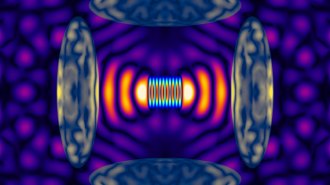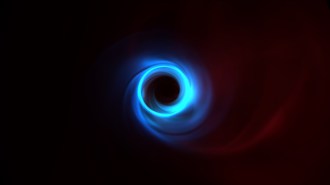Physics
Sign up for our newsletter
We summarize the week's scientific breakthroughs every Thursday.
-
 Physics
PhysicsSupercooled water has been caught morphing between two forms
A new experiment used ultrafast techniques to reveal high-density water transforming into low-density water at subfreezing temperatures.
-
 Physics
PhysicsGiant lasers help re-create supernovas’ explosive, mysterious physics
For the first time, scientists have re-created a type of shock wave that occurs in supernovas.
-
 Earth
EarthSTEVE may be even less like typical auroras than scientists thought
The purple-and-green, atmospheric light show nicknamed STEVE just got even stranger.
-
 Physics
PhysicsLIGO and Virgo’s gravitational wave tally more than quadrupled in six months
Scientists report 39 sets of spacetime ripples from just half a year of data.
-
 Quantum Physics
Quantum PhysicsGalileo’s famous gravity experiment holds up, even with individual atoms
When dropped, two types of atoms accelerate at the same rate despite their differences, much like objects in Galileo’s leaning Tower of Pisa experiment.
-
 Physics
PhysicsA photon’s journey through a hydrogen molecule is the shortest event ever timed
The shortest duration ever measured is 247 zeptoseconds, or trillionths of a billionth of a second.
-
 Animals
AnimalsThe diabolical ironclad beetle can survive getting run over by a car. Here’s how
The diabolical ironclad beetle is an incredibly tough little creature. A peek inside its exoskeleton reveals what makes it virtually uncrushable.
-
 Physics
PhysicsThe first room-temperature superconductor has finally been found
A compound of carbon, hydrogen and sulfur conducts electricity without resistance up to 15° C, but there’s a catch: It works only under high pressure.
-
 Physics
PhysicsFundamental constants place a new speed limit on sound
Physicists propose a new maximum rate that sound waves can travel under conditions normally found on Earth — 36 kilometers per second.
-
 Physics
PhysicsBlack hole revelations win the 2020 Nobel Prize in physics
The Nobel Prize in physics was awarded to a trio of scientists for their work on the most mysterious objects in the universe: black holes.
-
 Tech
TechA new thermometer measures temperature with sound
An acoustic thermometer takes temperature by listening to the faint hum that objects give off when they get hot.
-
 Space
SpaceThe first black hole image helped test general relativity in a new way
The Event Horizon Telescope’s iconic image of the black hole at the center of galaxy M87 once again shows Einstein was right.